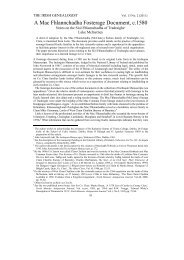Report Cover Vol I - Clare County Library
Report Cover Vol I - Clare County Library
Report Cover Vol I - Clare County Library
You also want an ePaper? Increase the reach of your titles
YUMPU automatically turns print PDFs into web optimized ePapers that Google loves.
The <strong>County</strong> <strong>Clare</strong> Wetlands Survey Patrick Crushell & Peter Foss 2008<br />
___________________________________________________________<br />
Eroding/upland rivers<br />
Annex 1 habitat under the EU Habitats Directive.<br />
Natural watercourses, or sections of these, that are actively<br />
eroding, unstable and where there is little or no deposition of fine<br />
sediment. Eroding conditions are typically associated with the<br />
upland parts of river systems where gradients are often steep, and<br />
water flow is fast and turbulent. For some rivers on the seaward<br />
side of coastal mountains, particularly in the west of Ireland,<br />
eroding conditions persist to sea level because of comparatively<br />
steep gradients over short distances, and high rainfall. Small<br />
sections of other lowland rivers may also be eroding where there<br />
are waterfalls, rapids or weirs. The beds of eroding/upland rivers<br />
are characterised by exposed bedrock and loose rock. Pebbles,<br />
gravel and coarse sand may accumulate in places, but finer<br />
sediments are rarely deposited. These rivers vary in size but are<br />
usually smaller and shallower than depositing/lowland rivers.<br />
The unstable rocky channels of eroding/upland rivers<br />
usually support little vegetation cover. Submerged rocks and<br />
boulders may be colonised by aquatic mosses. Exposed rocks and<br />
wet shaded banks may also support extensive cover of lichens and<br />
liverworts. Higher plants are generally rare or absent except in<br />
places where fine sediments are trapped.<br />
Pressures from eutrophication, overgrazing, excessive<br />
fertilisation, afforestation and the introduction of invasive alien<br />
species are the main threat to this habitat. Almost two thirds of the<br />
rivers assessed by the Environmental Protection Agency (EPA) are<br />
at risk of failing to meet their environmental objectives.<br />
Many of the streams and rivers of <strong>County</strong> <strong>Clare</strong> fit this category.<br />
One such example is the upper reaches of Annageeragh River in West <strong>Clare</strong>.<br />
Depositing/lowland rivers<br />
Annex 1 habitat under the EU Habitats<br />
Directive.<br />
Watercourses, or sections of these, where fine<br />
sediments are deposited on the river bed.<br />
Depositing conditions are typical of lowland areas<br />
where gradients are low and water flow is slow and<br />
sluggish. These rivers vary in size but are usually<br />
larger and deeper than those above. In a natural<br />
state these rivers erode their banks and meander<br />
across floodplains.<br />
Plant and animal communities are influenced by<br />
numerous factors including substratum type, water<br />
force, nutrient status, water quality, channel size,<br />
water depth, human impact, disturbance and<br />
shade. Within a river channel there may be deep<br />
pools, backwaters, banks or mid-channel bars of<br />
gravel, sand or mud, in addition to vegetated<br />
islands and fringing reed beds. The substratum of<br />
depositing/lowland rivers comprises mainly fine<br />
alluvial or peaty sediments. Vegetation may include<br />
floating and submerged aquatics, with fringing<br />
emergents in shallow water or overgrowing the<br />
banks.<br />
Due to their location in lowland areas, where agricultural activities are prevalent and with increased population pressures,<br />
most of these rivers have been modified to some extent to control water flow, facilitate navigation or prevent flooding and<br />
erosion. Canalised or walled sections of rivers, dredged or deepened sections, and artificial earth banks may occur. These<br />
activities all alter the natural river bank and adjacent vegetation occurring along such rivers.<br />
The principal threats to these rivers include nutrient enrichment arising from agricultural practices, human<br />
developments along river banks and the introduction of invasive alien species, and utilization for sport and leisure activities.<br />
There are some examples of this habitat occurring in <strong>County</strong> <strong>Clare</strong> such as the Lower River Shannon and Lower River Fergus.<br />
22
















